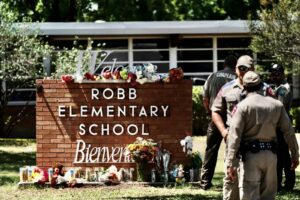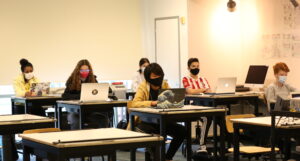
photo courtesy of Public Domain
Since the 2010s, school shootings have consistently risen. In light of these tragic nationwide events, conversations around school safety have been amplified. As a result, policymakers, school administrators and educators reevaluated campus security measures. Lick-Wilmerding High School and surrounding schools have made continuous efforts to foster a positive school learning environment, while reinforcing current and newly implemented safety protocols.
David Reidman, founder of the K-12 National School Shooting Database, defined school shootings as a gun being brandished, fired, or a bullet hitting school property for any reason.
School shootings are typically not premeditated, but rather a gruesome outcome of student fights on campus. According to the database, the number of school shootings incremented from 30 incidents per year in a 50 year period to almost 300 per year.
“Students carry guns to school almost every day because they are scared of getting victimized before school, at school, and after school,” Reidman said. Guns have been promoted as a default, necessary system of defense, which can be misused by troubled youth.
38% of school shooters in the U.S. are current students and 2.7% are former students; the remaining 60% of shooters are not affiliated with schools or are unknown. As of September 6, at least 46 school shootings in the United States have occurred in 2024. Of these shootings, 13 were on college campuses, and 33 were on K-12 school grounds. In 2023, 82 school shooting incidents occurred, and in 2022, there were 46 fatalities. September 2024 has had the most victims killed and wounded in the past decade, with the planned attack at Apalachee High School in Georgia being only 1 of 33 planned shootings.
In 2022, following the atrocities of the Uvalde, Texas school shooting, President Joe Biden signed the first bipartisan gun legislation which included a $300 million federal grant funding school security measures. The ruling aimed to save lives, taking the necessary steps to ensure school safety and prevent the next school shooting.
In response to nationwide school shootings, LWHS has issued a variety of safety measures including an Emergency Preparedness Team (EPT). The team is co-chaired by Raquel Olivia-Gomez, Antonio Chin and Jeanette Moore. Other members of the team include Jorge Garcia, Junior Mendieta, Liz Pulido, Maurice Williams, Molly French, Maya Santos, Troy Yochelson and Monica Alatorre.

photo courtesy of Public Domain
Additionally, the team receives support from an outside consultant through Joffe Emergency Services. LWHS’ EPT has functioned for the past seven years, and meets approximately every month. EPT’s purpose is to review, draft and implement policies and procedures around emergency situations. The team schedules, coordinates and executes drills, life safety system tests, inventory and replenishes emergency supplies as needed.
This year, the extensively trained Site Supervisor of Health, Safety, and Security, Antonio Chin, was tasked with on-the-clock campus supervision. Chin’s role as site supervisor is to inspect any vulnerabilities the school has, and to propose recommendations on how the school can follow through these susceptibilities.
“My responses to threats are typically immediate. My way of thinking would be to question if the students are safe. Is the threat internal or external?” Chin said.
Apart from fundamental lockdown drills, Chin has implemented a modified system of badges for visitors to be identified on campus. There are three different categories: a blue badge is applicable for vendors and contractors, gold for parents, and red for visitors. “The badges serve a great purpose of identifying who is coming in and out of the building,” Chin said.
Additionally, Chin aims to install a new system of motion sensor security cameras. These cameras will be able to monitor doors; if a door is opened externally, pulled, or tugged on, the front desk will be notified to check out the disturbance.
When asked about school safety, Téa Theodospoluous ’26 said, “I worry about the campus structure. Most things are made of glass here, like the lobby and most classroom doors. Breaking in would be quite simple, as the fences aren’t that tall either.”
Participating in the design process of the updated campus, LWHS Architecture teacher, Goranka Poljak-Hoy considered the effects of having a predominantly glass made campus. “All of the glass implemented on each campus building is tempered glass, meaning it is strengthened and breaks up in little pearls other than shards. The most recent safety addition is located on the top floor of the academic building where the glass is triple-pane, ” Poljak-Hoy said.
Similar to LWHS, local public schools have issued safety protocols to prepare for on campus threats. However, a significant barrier to implementing these security measures is affected by district funding; not all schools have sufficient funds to support safety expenses. Although the San Francisco Unified School District (SFUSD) has school modernization projects funded by municipal bonds, equity issues remain prevalent in a school’s ability to afford proper security advances and training for teachers and faculty.
Following the Standard Response Protocol Program outlined by the I Love You Foundation, SFUSD implements a list of five protocols in their schools: Hold, Lockdown, Secure, Evacuate and Shelter, and can be applied to any number of incidents that might happen at a school site. In the case of an active threat, the school would go into lockdown.
“With a lockdown, we just lock our doors and get the kids away from the window of the classroom. If it’s a stage two lockdown, that means we’re allowed to go to the football field,” Lowell History Teacher Mathew Furey said.
In order to ensure the efficiency of drills, training teachers is pivotal. “When sites complete drills, they get to practice the response protocols, and more importantly, the administrative staff can reflect afterwards to see where they need to improve their response,” the SFUSD Director of Emergency Services said.
A hurdle in issuing effective safety measures would be implementing something new and managing to get people into a habit. “As you know, once people build on this notion of safety, they continue to rely on it, hoping the trusted system won’t fail,” LWHS Head of School Raj Mundra said.
In reinforcing school safety measures, a pivotal method stems from a positive classroom environment. “In an intentionally diverse community, sometimes things get complex because people have different backgrounds. People are smart, people are passionate and people are opinionated.” Mundra said. In efforts to prevent potential school shooting threats, schools like LWHS continuously seek ways to foster a positive learning environment where each student can engage with one another, actively deepening the sense of belonging within the school community.







